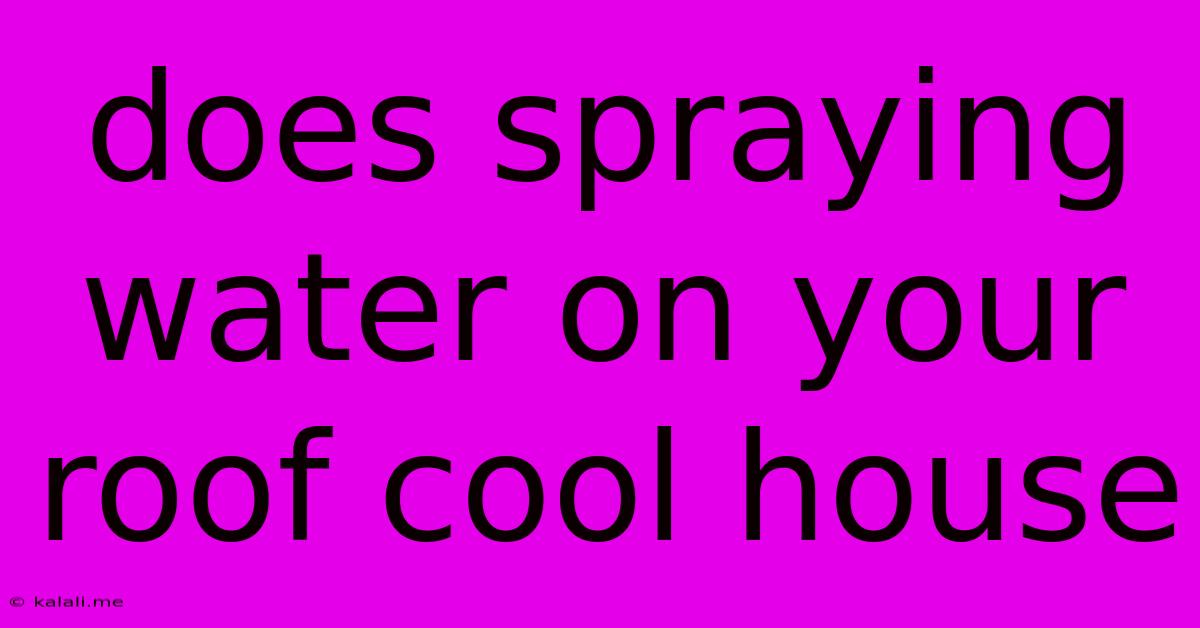Does Spraying Water On Your Roof Cool House
Kalali
Jun 08, 2025 · 3 min read

Table of Contents
Does Spraying Water on Your Roof Cool Your House? A Deep Dive into Evaporative Cooling
Summer heat can be brutal, driving up energy bills and making your home uncomfortable. Many homeowners wonder if a simple solution like spraying water on their roof could offer relief. The short answer is: yes, but with important caveats. This article explores the science behind evaporative cooling and examines the effectiveness, practicality, and potential drawbacks of this method.
Understanding Evaporative Cooling: The Science Behind the Spritz
The principle behind this technique is evaporative cooling. When water evaporates, it absorbs heat energy from its surroundings. This heat absorption leads to a cooling effect. Spraying water onto a hot roof provides a large surface area for evaporation, potentially lowering the roof's temperature and, consequently, the temperature inside your home.
Factors Affecting Effectiveness:
Several factors influence how well spraying water on your roof cools your house:
-
Climate: This method works best in hot and dry climates. High humidity reduces the effectiveness of evaporative cooling because the air is already saturated with water vapor, hindering evaporation. In humid climates, the water may simply sit on the roof, adding weight and potentially causing damage without significant cooling.
-
Roof Material: Dark-colored roofs absorb more heat than light-colored roofs. Spraying water on a dark roof can be more effective initially, but the cooling effect may be short-lived unless the water continuously replenishes the surface. Light-colored roofs, already reflecting more sunlight, may not see as dramatic a temperature drop. Roof type is a crucial factor to consider.
-
Water Source and Pressure: Consistent, adequate water supply is essential. Low water pressure may lead to insufficient coverage, rendering the method ineffective. The water quality also matters; mineral deposits could leave unsightly stains on your roof.
-
Roof Insulation: A well-insulated roof significantly reduces heat transfer to the interior. Spraying water provides additional cooling but becomes less critical with proper insulation. Insulation is a crucial part of a home cooling strategy.
-
Wind: Wind enhances evaporation. A breezy day will increase the cooling effect of the water spray. Conversely, calm conditions will limit evaporation and reduce effectiveness. Air circulation is key.
Practical Considerations and Potential Drawbacks:
While the idea seems simple, there are practical challenges:
-
Cost: The constant water usage can significantly increase your water bill, especially in drought-prone areas. This method is hardly a cost-effective cooling solution for long-term use.
-
Maintenance: Regular maintenance of the spraying system is necessary to ensure proper function and prevent clogs or malfunctions.
-
Potential Damage: Excessive moisture can damage certain roofing materials, especially if the system is not correctly installed or managed. Roof damage is a serious concern. Certain roofing materials are better suited to this method than others.
-
Algae and Mold Growth: Constant moisture can create an environment conducive to algae and mold growth on your roof, leading to both aesthetic and structural issues.
Alternatives to Roof Spraying:
More efficient and sustainable methods for home cooling exist:
- Proper Insulation: Effective insulation is a cornerstone of energy efficiency.
- Improved Ventilation: Adequate attic ventilation reduces heat buildup.
- Energy-Efficient HVAC Systems: Investing in a high-efficiency air conditioner provides reliable and consistent cooling.
- Solar Reflectance Coatings: These coatings significantly reduce heat absorption by the roof.
- Landscaping: Strategic planting of trees can provide shade and reduce the amount of heat absorbed by the roof and walls.
Conclusion:
Spraying water on your roof can offer temporary cooling relief, especially in hot and dry climates. However, its effectiveness is limited by various factors and may not be a practical or sustainable solution for long-term cooling. Before implementing this method, carefully consider the climate, roof material, and potential drawbacks. More effective and environmentally friendly cooling strategies, such as proper insulation and energy-efficient HVAC systems, should be prioritized.
Latest Posts
Latest Posts
-
Wiring Ceiling Fan And Light With Separate Switches
Jun 08, 2025
-
Is Name Of Novel In Italics
Jun 08, 2025
-
Thank You And You As Well
Jun 08, 2025
-
Crop To Selection To Crop Multiple Layers
Jun 08, 2025
-
Wiring Diagram Two Lights One Switch
Jun 08, 2025
Related Post
Thank you for visiting our website which covers about Does Spraying Water On Your Roof Cool House . We hope the information provided has been useful to you. Feel free to contact us if you have any questions or need further assistance. See you next time and don't miss to bookmark.